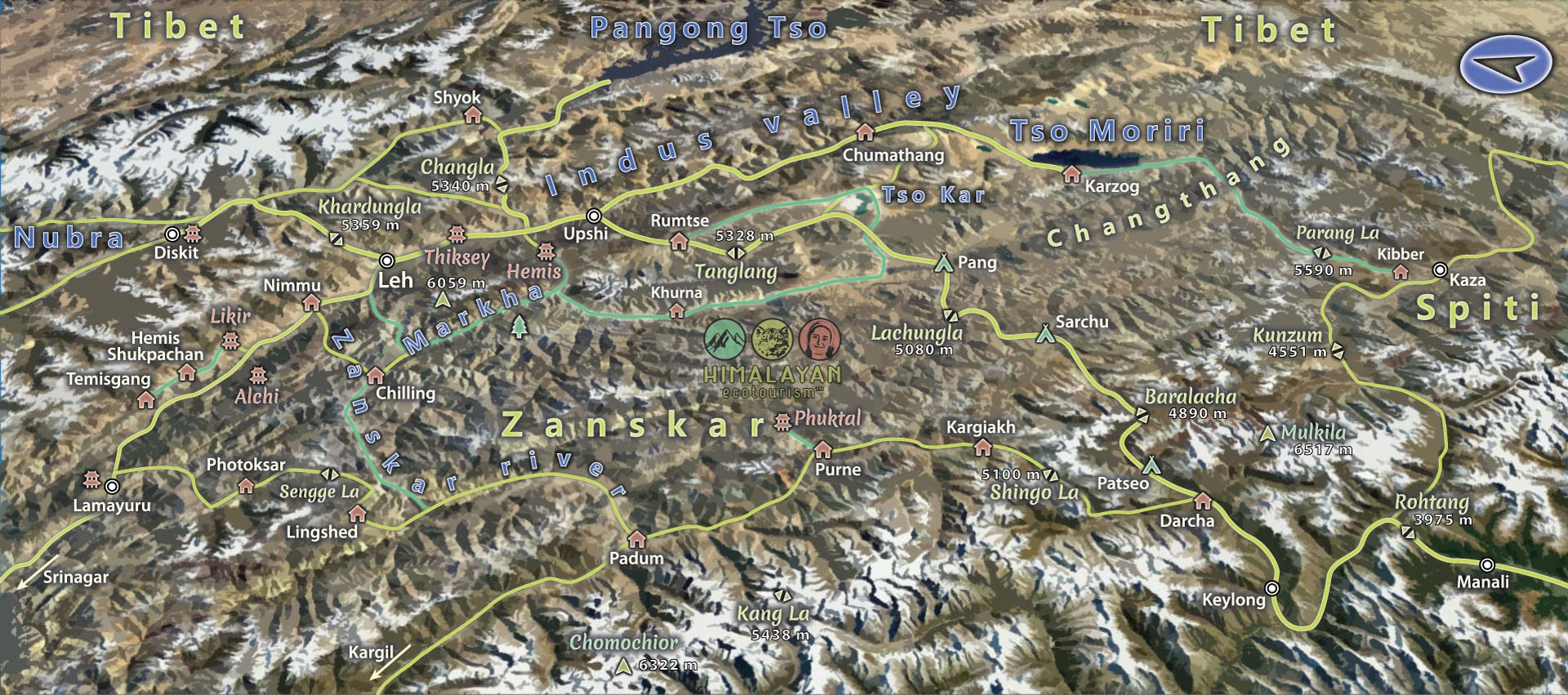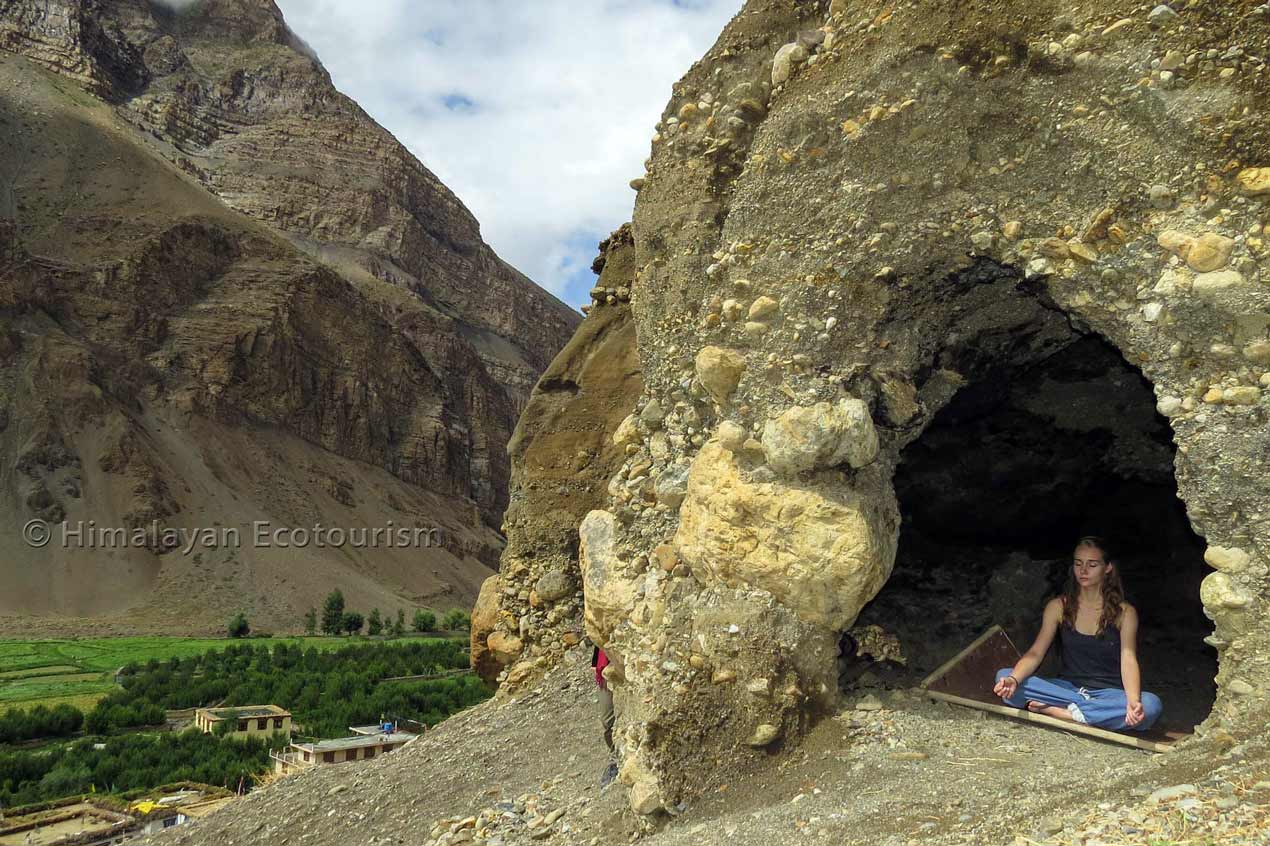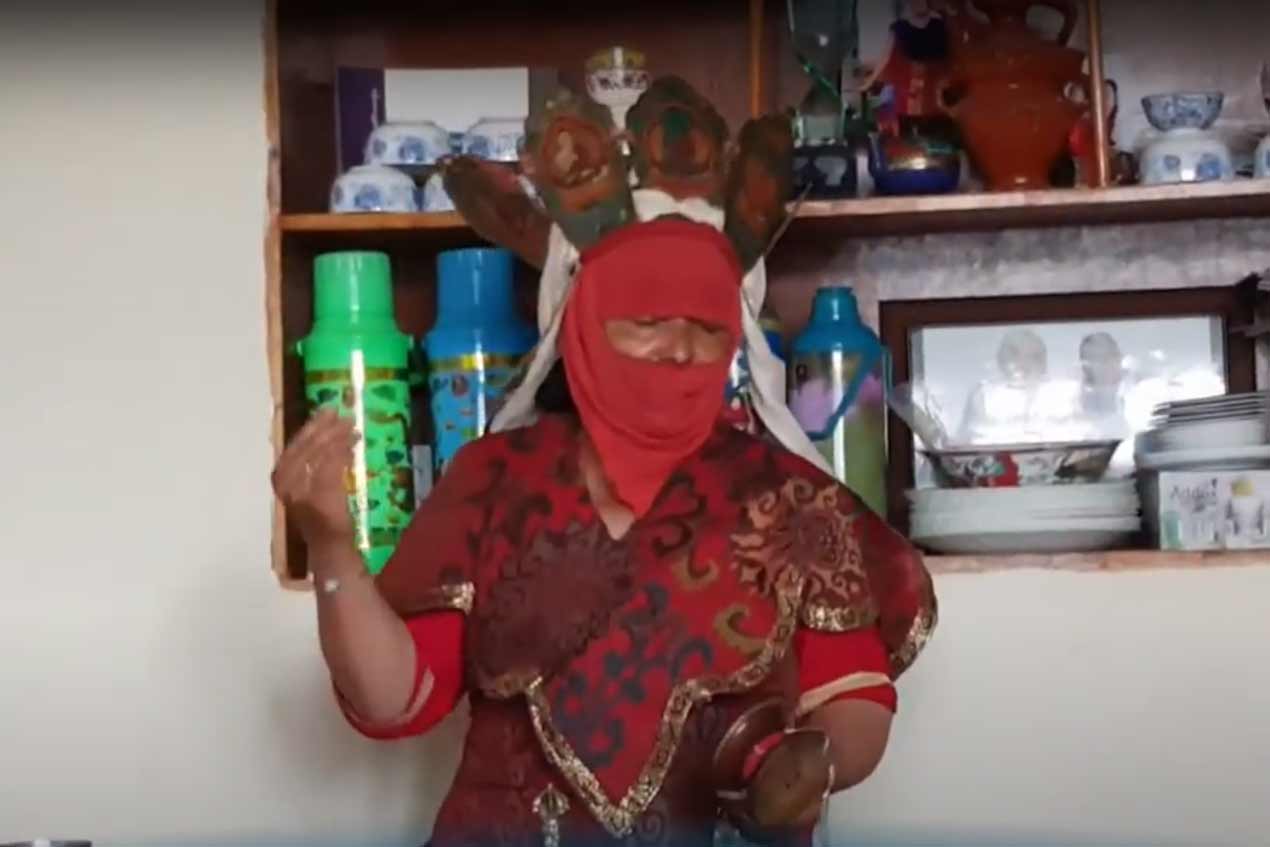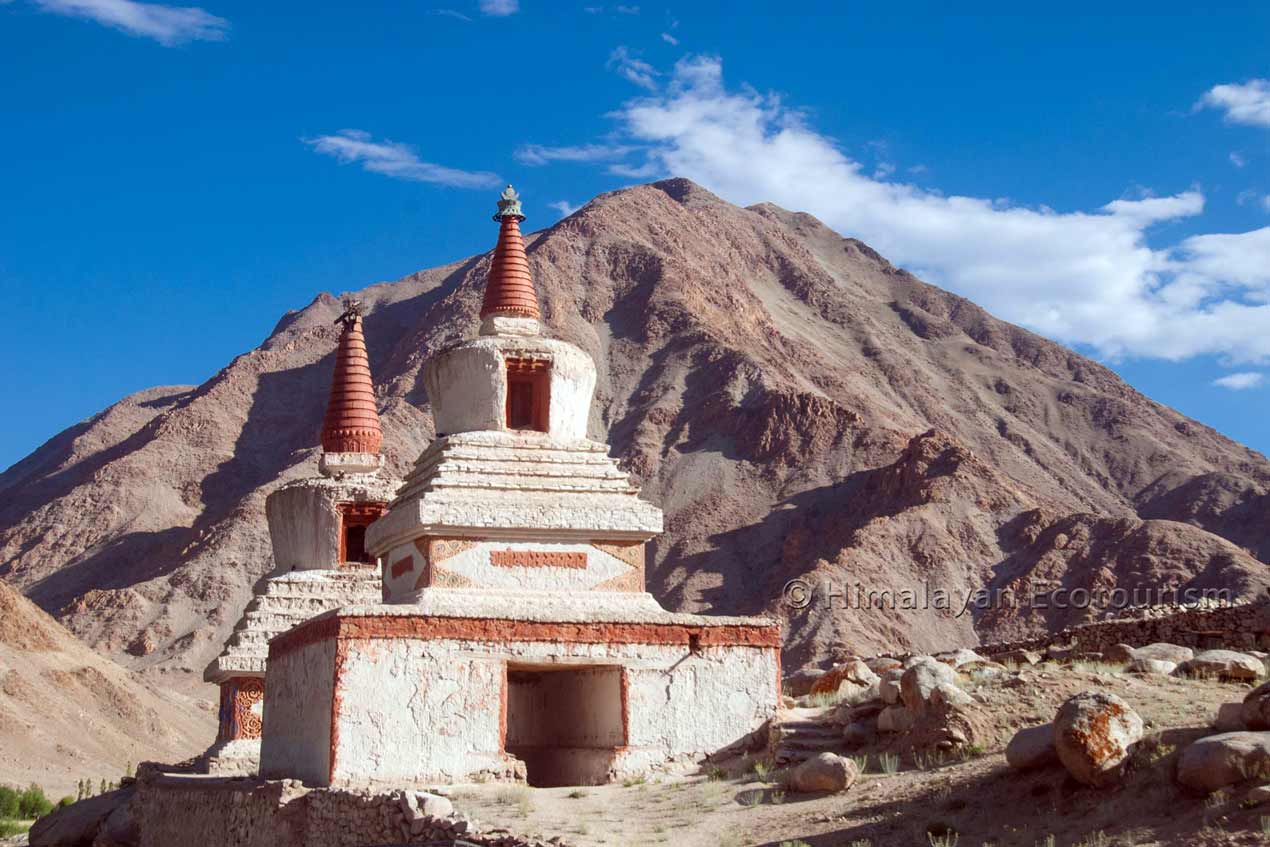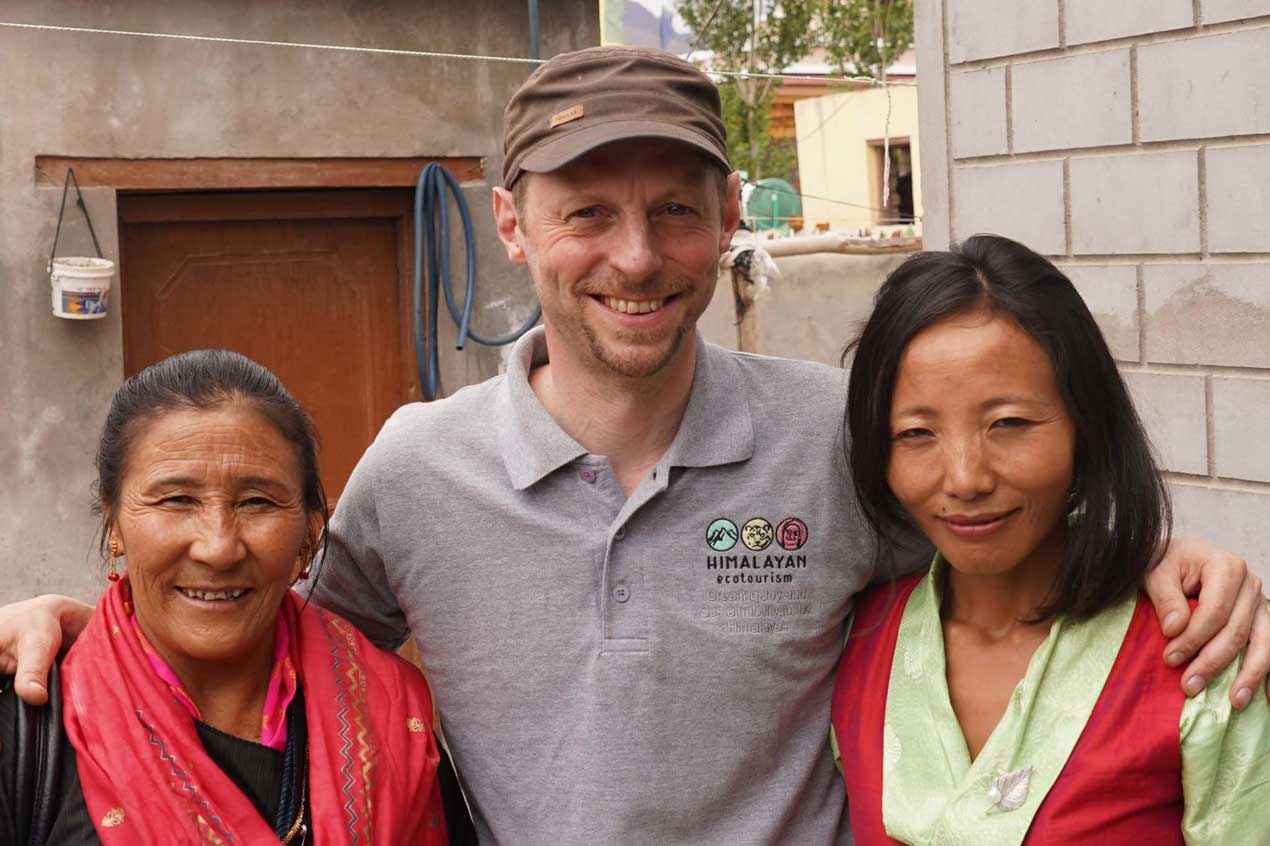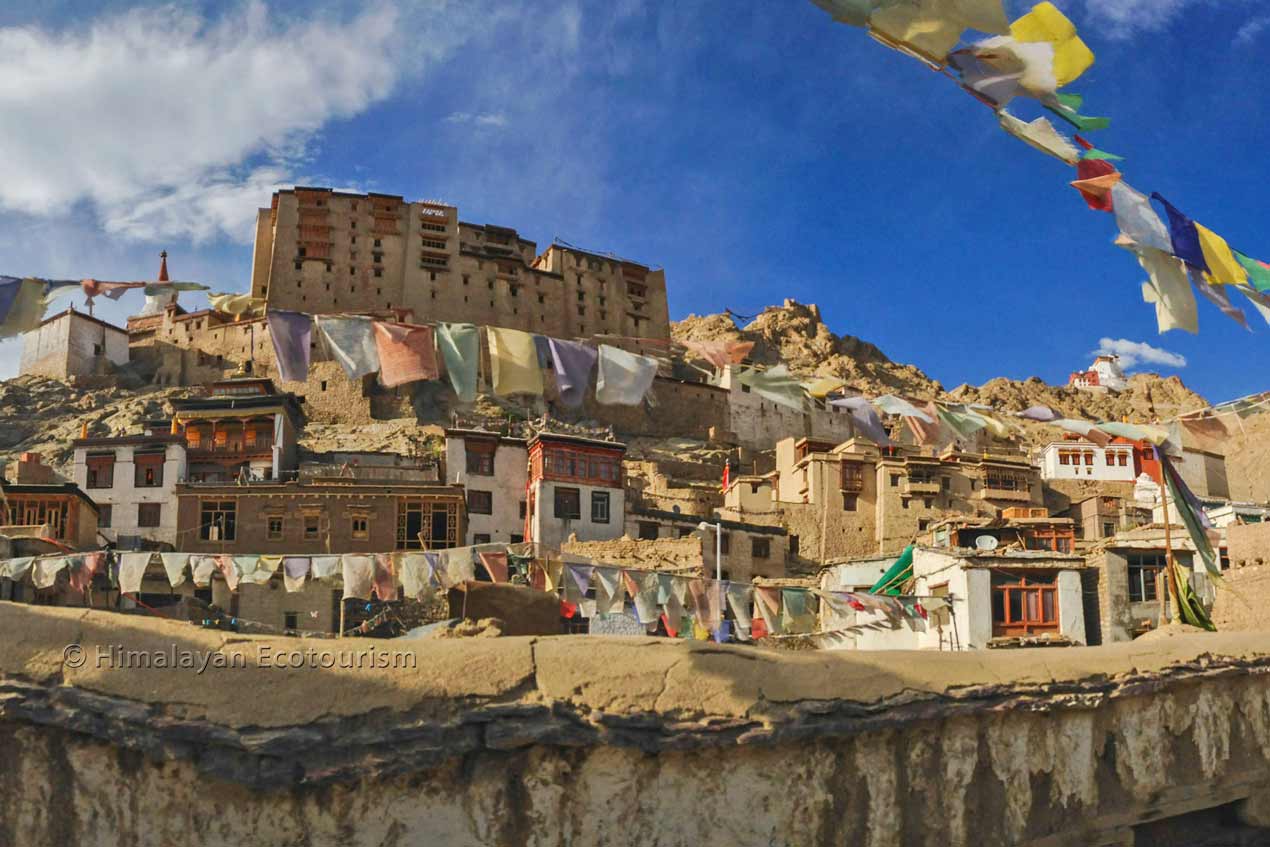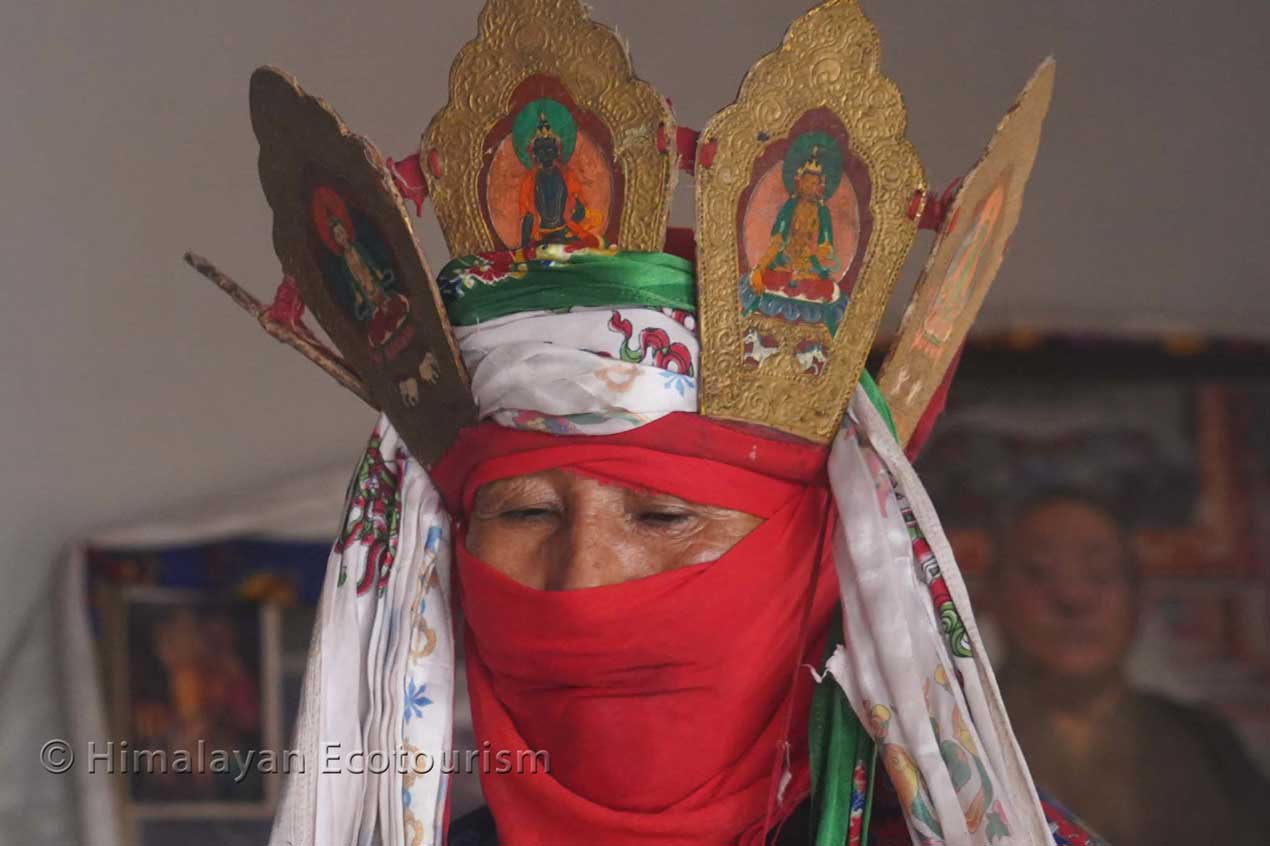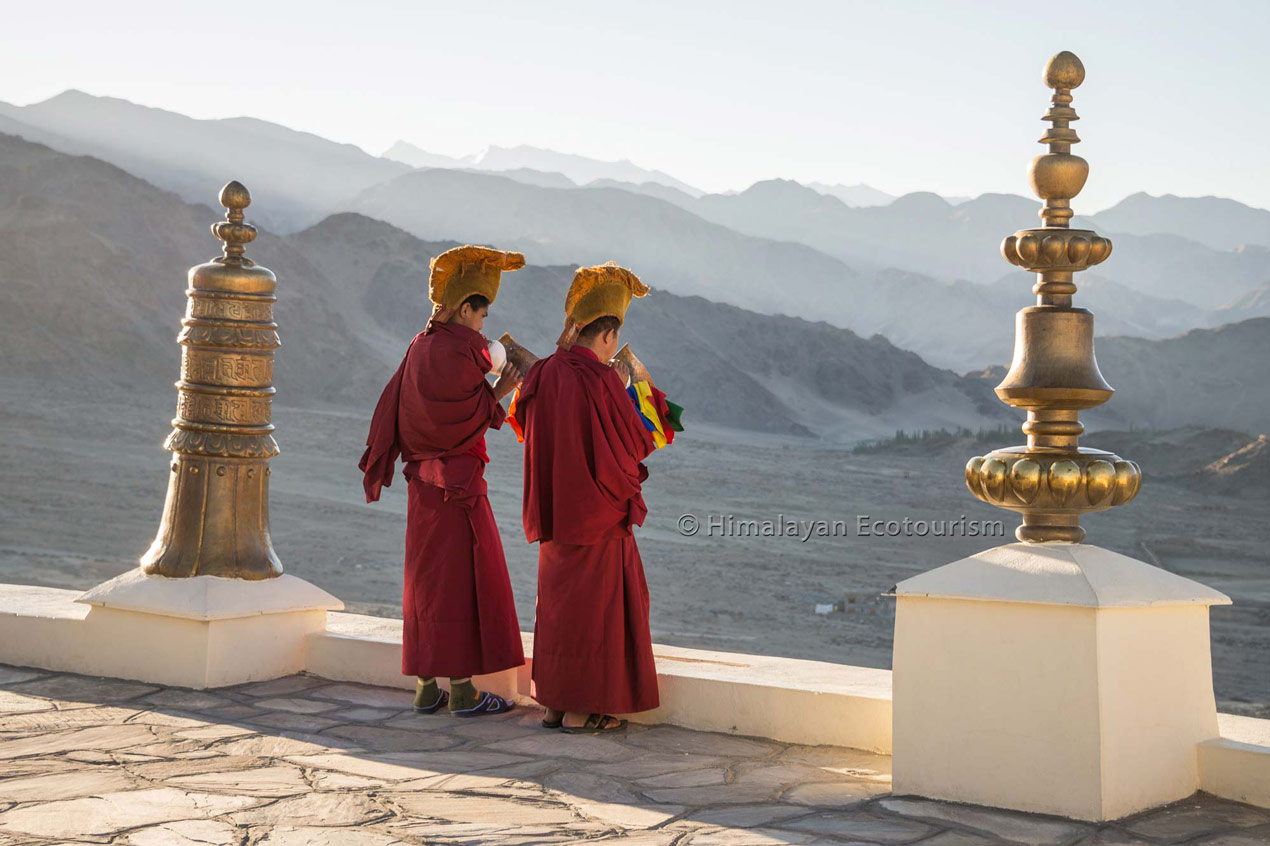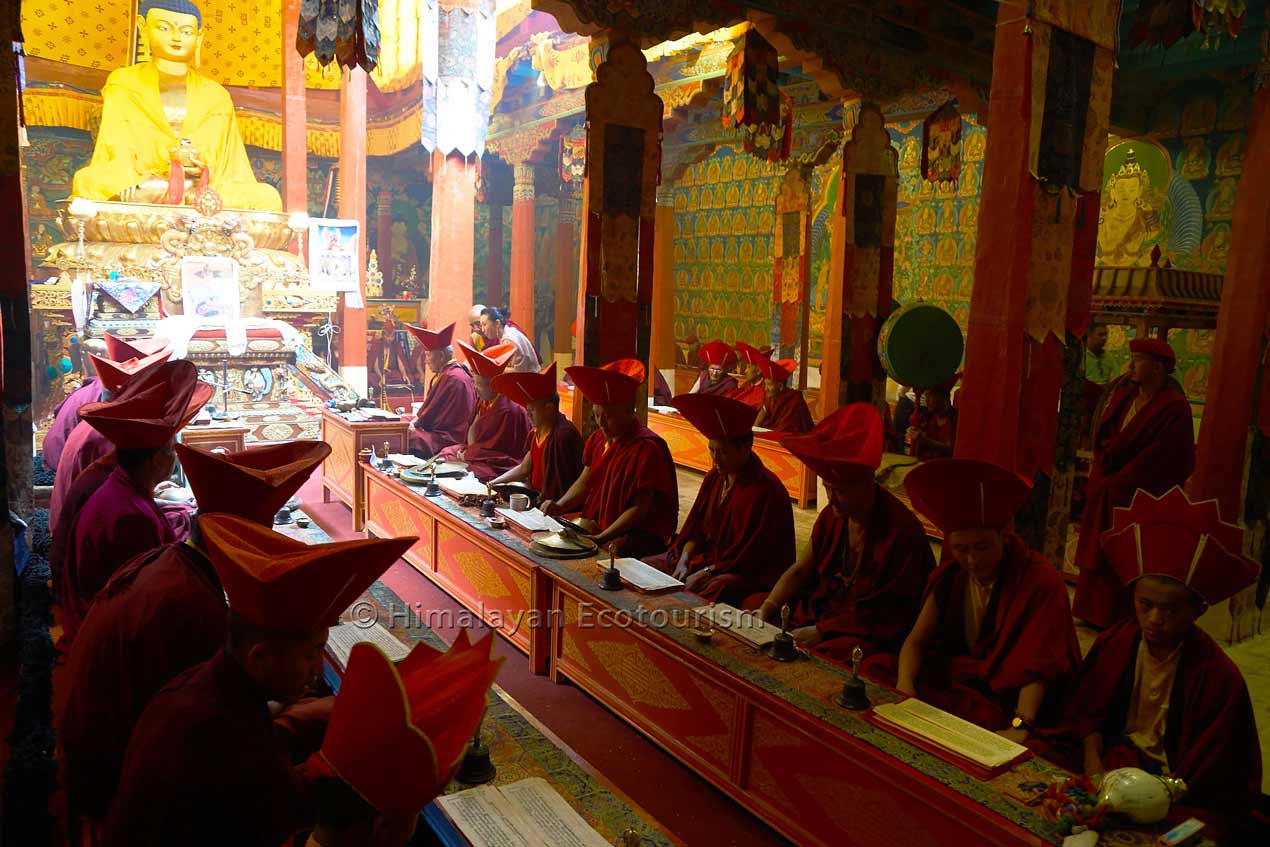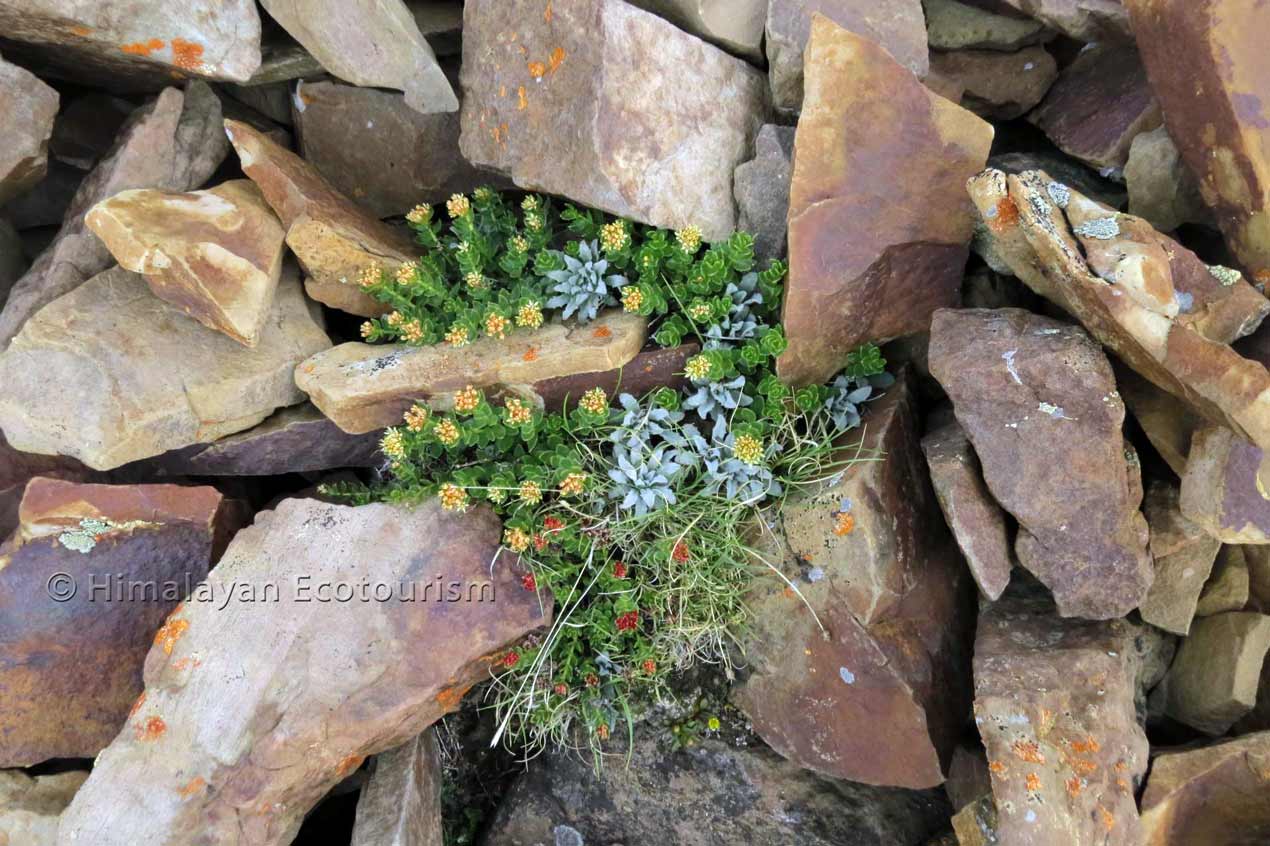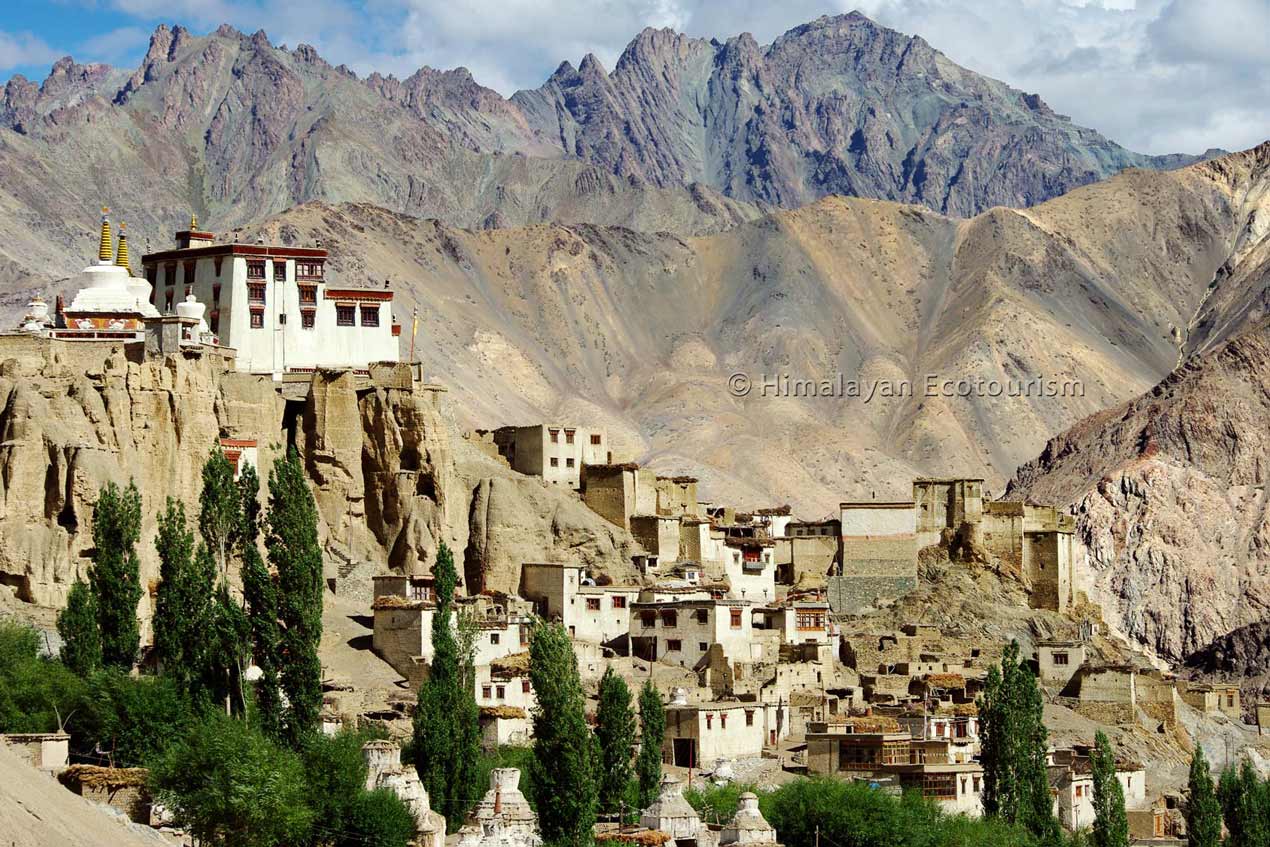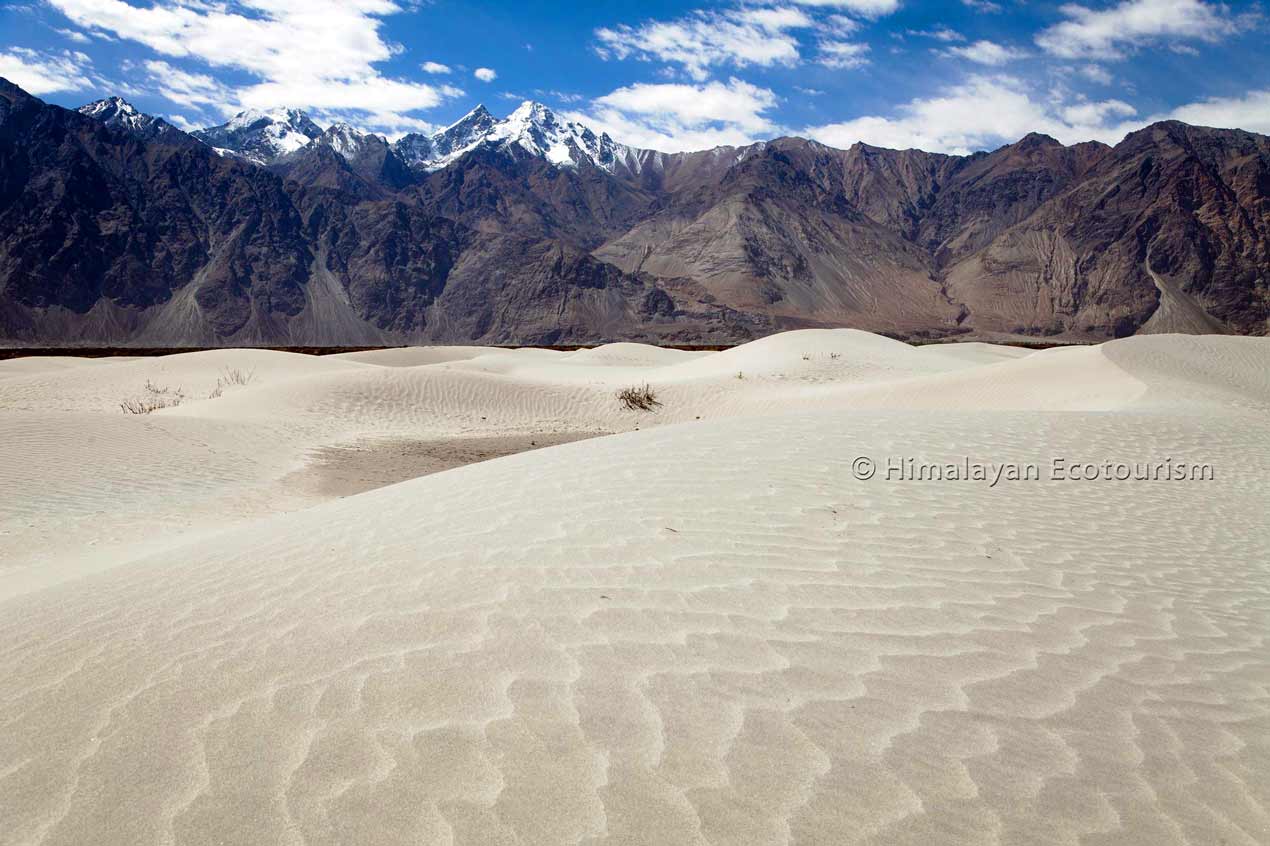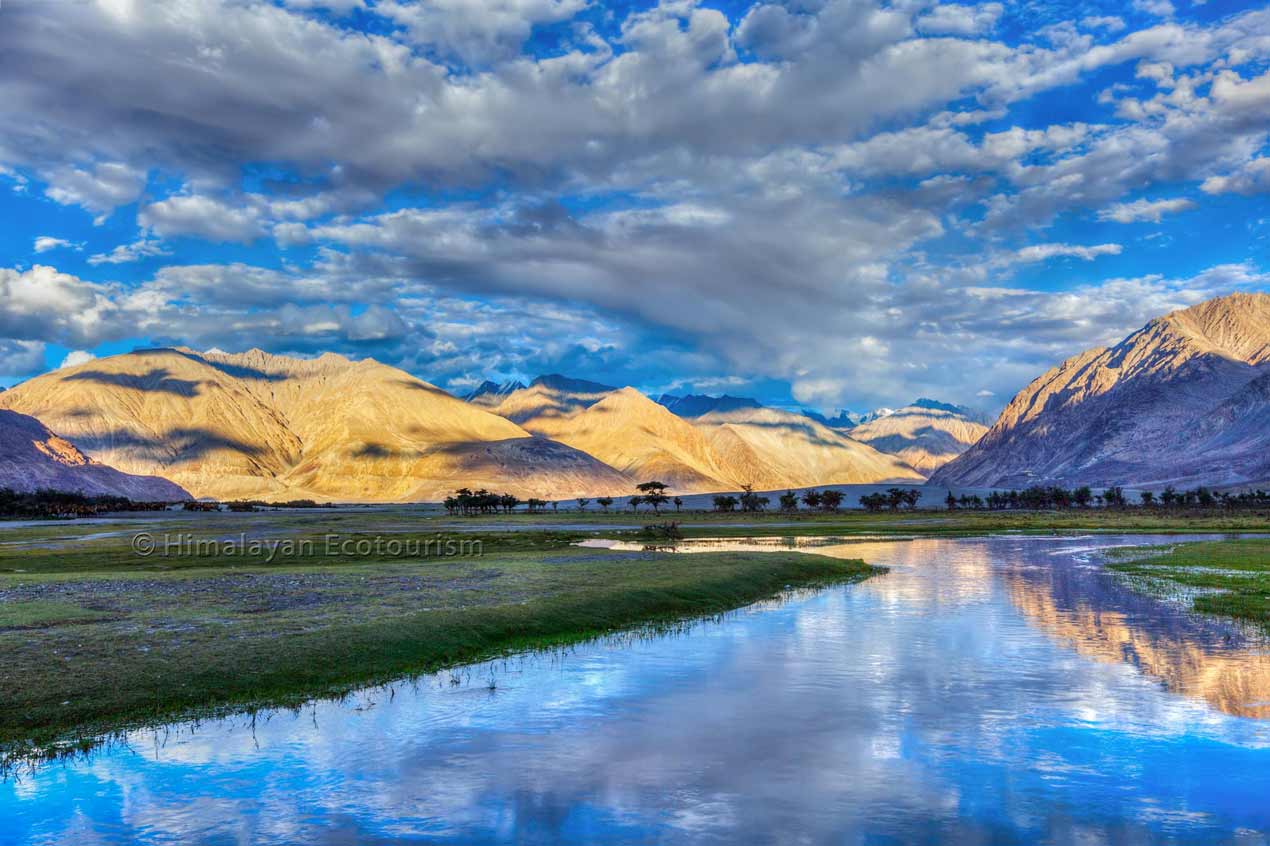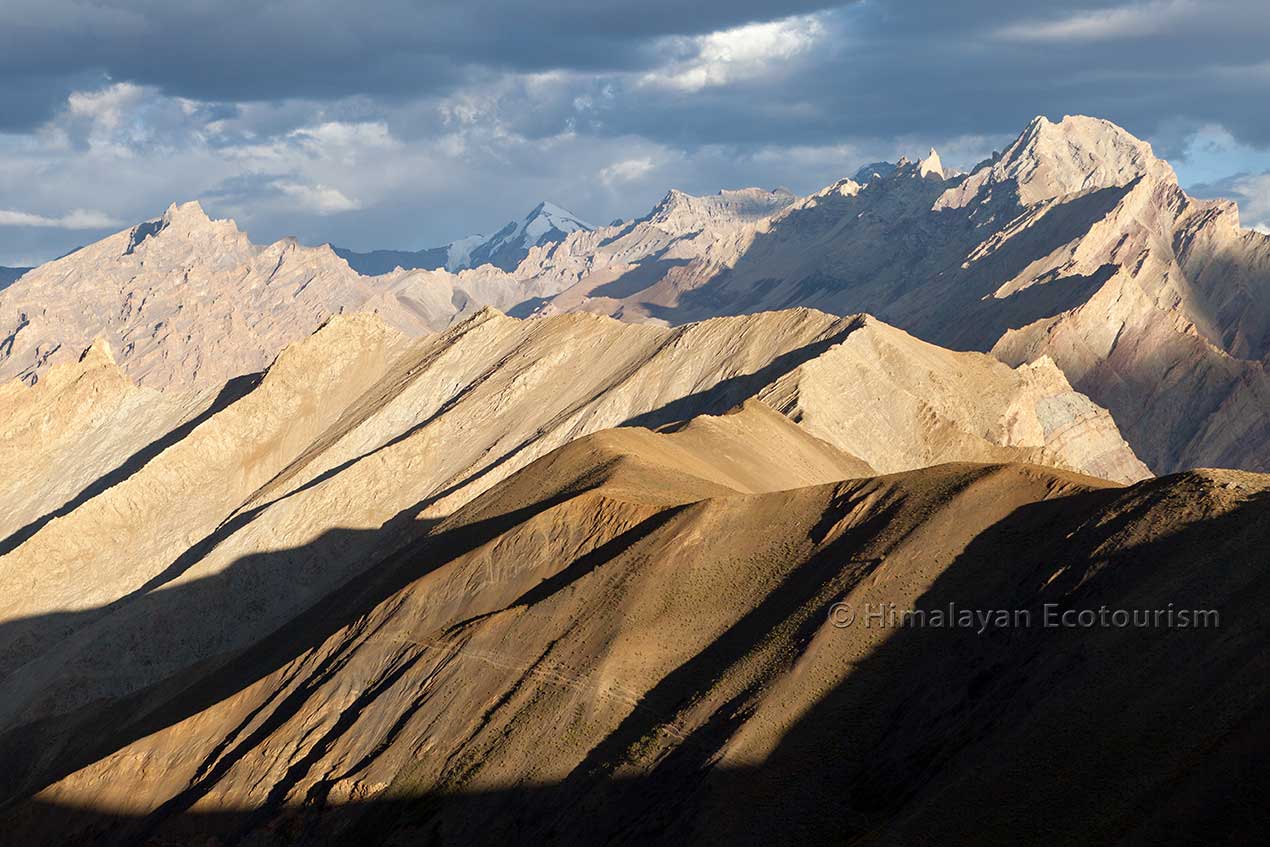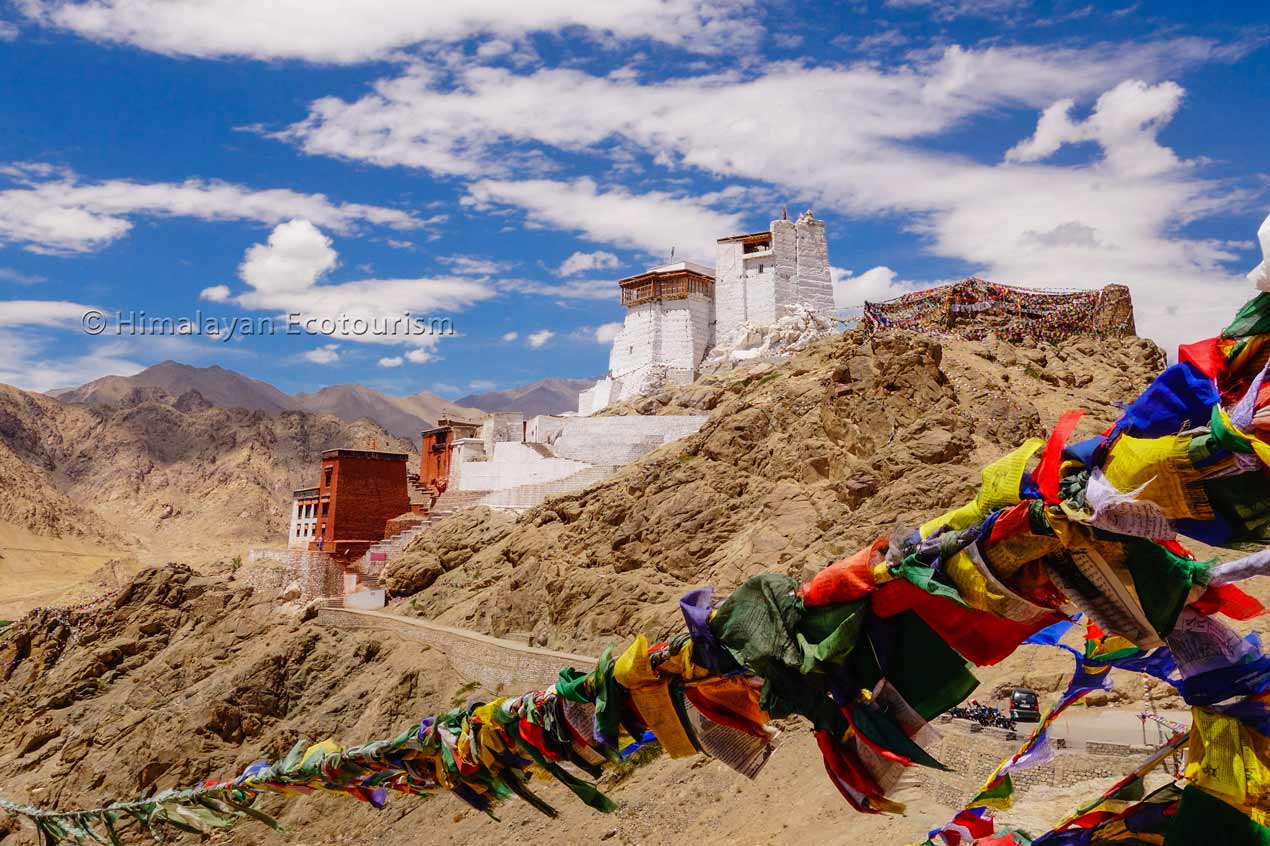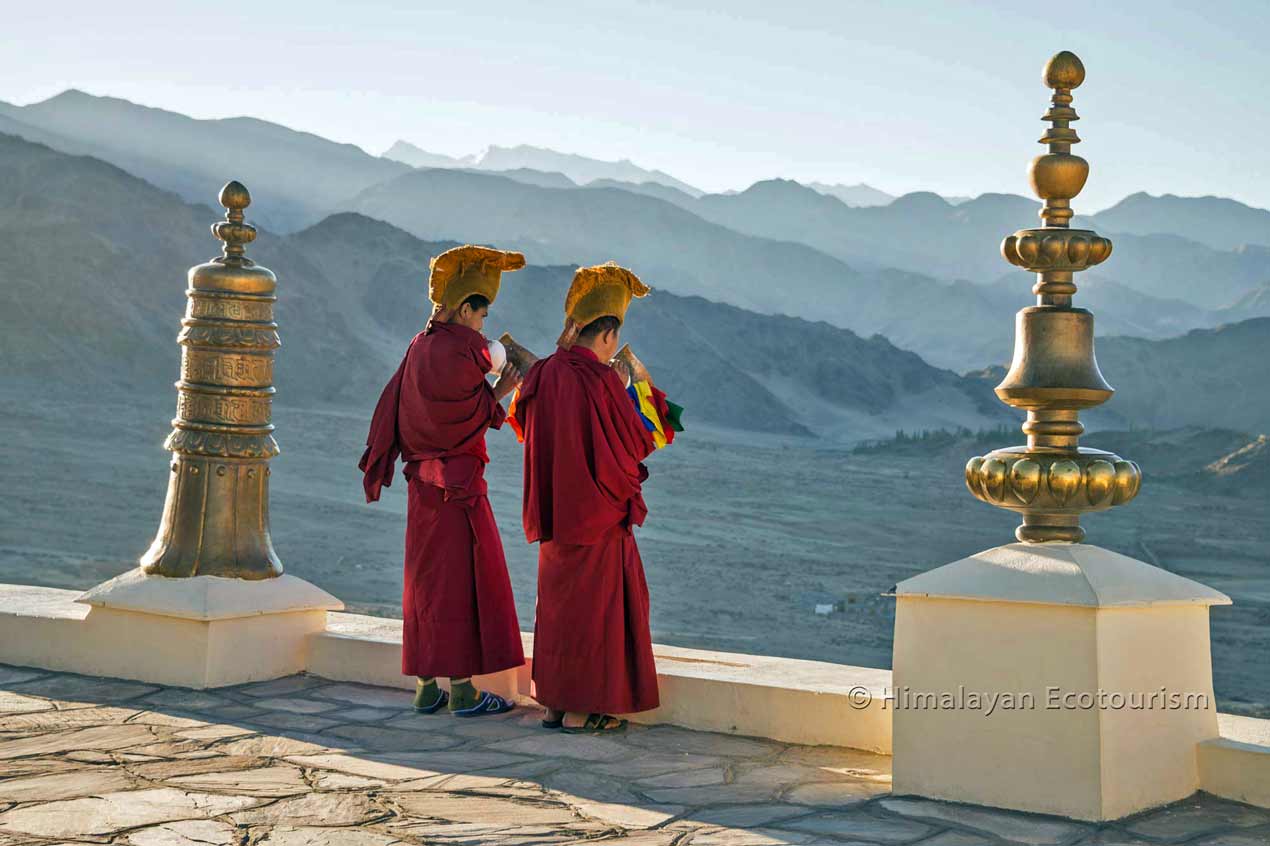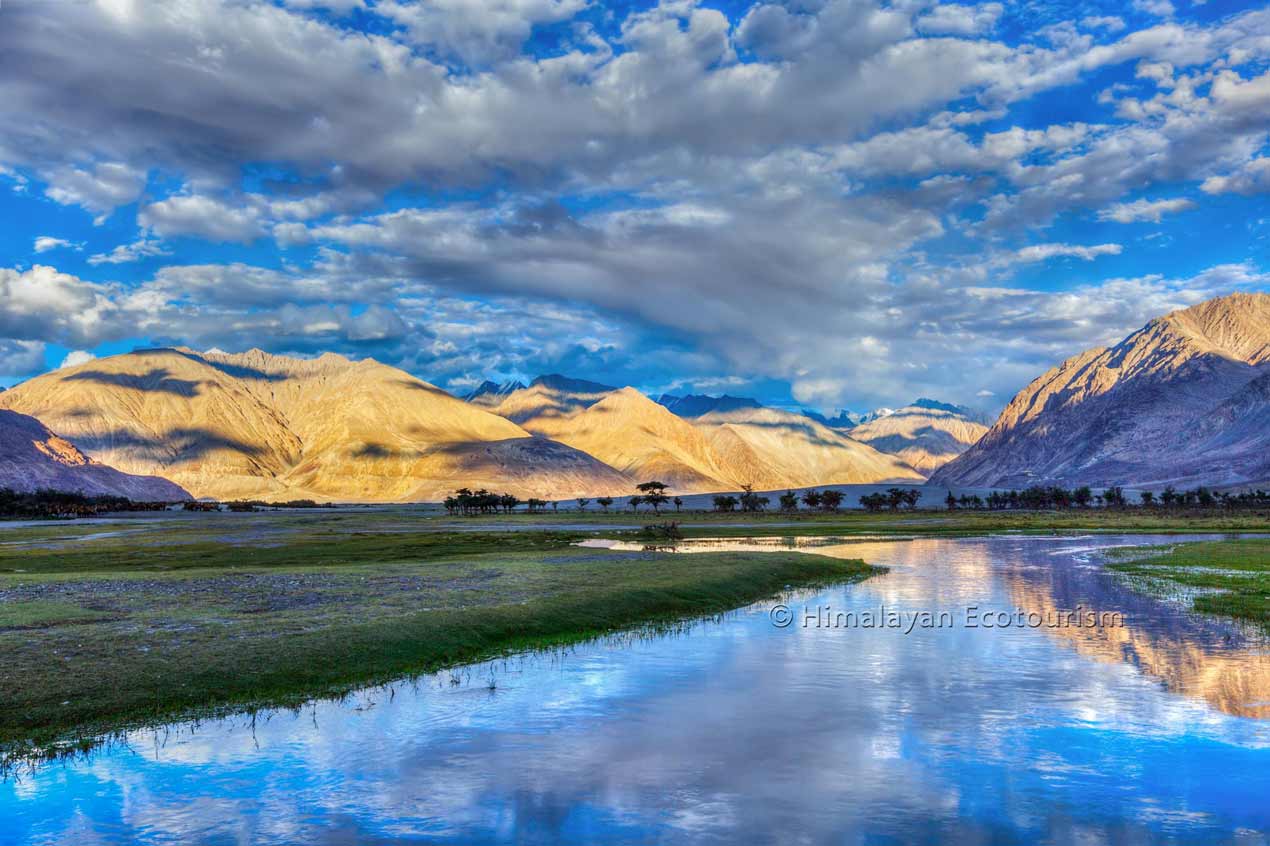Spiritual Tour in Ladakh
Places like these on our planet, naturally take our minds to another state of consciousness and calm our restlessness. This is what makes the Himalayas so magical. Not only the Himalayas but also the northern parts of this chain which extend over the Tibetan plateau and of which Ladakh is a part are a sight to behold
It is for this reason that the Himalayas are portrayed as the cradle of Hinduism and Buddhism. Ladakh is an important refuge for the Tibetan Buddhist Community.
Most visitors go to see Buddhist monasteries to appreciate their architecture, the beauty of their frescoes and statues or simply to enjoy the very special and peaceful atmosphere that emanates from them.
With Himalayan Ecotourism, it is also possible to spend time there, to participate in certain rituals such as morning prayers, and even to receive gifts in the form of teachings.
This is what makes Himalayan Ecotourism special. You not only see the culture but get to experience it.
Spiritual journey in Ladakh does not stop at just Buddhism. You can learn the traditional forms of meditation techniques like Vipassana.
Even before Buddhism, the inhabitants of Ladakh practiced an animist and shamanic cult. The Shamans still exist in Ladakh and we invite you to meet them.
It should also be noted that there persists a tradition to care for the plants and minerals. This knowledge is transmitted from one generation to another in the families of the Amchi.
Mystical Monasteries – Come and witness the grandeur and simplicity all at once at the Buddhist Monasteries of Ladakh. You will be one step closer to witnessing how the monks live their lives and how they achieve a sense of calm despite everything going around in the world.
Luring Landscapes – Ladakh is unlike any other mountainous region in India. Its uniquely weathered mountains, roads with a 360-degree view, an unbelievable night sky and the ever-so-warm people of the villages make the place worthy of the title of ‘Heaven on Earth’.
Charismatic Culture – Although Buddhism is the dominantly practiced religion in this particular region, it warmly invites people from all backgrounds and religious identities. When you interact with the people of Ladakh, you will come to realise that it is not religion that binds people, but their warmth and hospitality.
Himalayan Ecotourism invites you to experience the spirituality of ladakh.


JAN
Avoid
FEB
Avoid
MAR
Avoid
APR
Avoid
MAY
You may go
JUN
Good to go
JUL
Best time to go
AUG
Best time to go
SEP
Best time to go
OCT
Good to go
NOV
Avoid
DEC
Avoid
Tibetan Buddhism in Ladakh
Over the past two millennia, Ladakh has had a long history of invasions and migrations.
Both Muslim and Buddhist influences have therefore shaped the culture and architecture of Ladakh. Despite this, since the Namgyal dynasty, which still exists today in Ladakh, Tibetan Buddhism remains the dominant spiritual tradition..
Since Tibet suffered the Chinese invasion, Ladakh is known as the “little Tibet of India.” This is a territory where the local population can freely practice their traditions.
Each monastery in Ladakh is a teaching center of Buddhism for monks. Establishments have even been created for education that is easily accessible to all, especially to the foreigners. You must therefore speak English to take the lessons, but if this is not the case, our English-speaking guide can help you with communication.
If you are interested in the philosophy of Tibetan Buddhism, and want to learn the essentials directly from the sages and monks of Ladakh, we will organize your trip centered on the teaching of Buddhism in the company of a Lama.
Sects or Schools of Tibetan Buddhism in Ladakh
Tibetan Buddhism in Ladakh is traditionally divided into four main sects or schools, each with distinct philosophies, teachings, and practices. These schools developed over centuries and have spread throughout the Tibetan Plateau and the Himalayan regions, including Ladakh. Here are the main sects found in Ladakh :
1. Gelugpa (Yellow Hat Sect)
- Meaning : Gelugpa means “the virtuous school” and is also called the “Yellow Hat” sect due to the distinctive yellow hats worn by its monks.
- Founding : It was founded in the 14th century by Je Tsongkhapa, a renowned Tibetan Buddhist scholar and reformer.
- Key Characteristics : The Gelugpa school emphasizes monastic discipline, scholarship, and a structured approach to Buddhist practice. The Dalai Lama belongs to this sect.
- Notable Monasteries in Ladakh : Likir Monastery, Spituk Monastery, and Thiksey Monastery.
2. Kagyu (Oral Lineage or White Hat Sect)
- Meaning : “Kagyu” translates to “oral lineage” or “whispered transmission,” highlighting the school’s emphasis on a direct, teacher-to-student transmission of knowledge.
- Founding : The Kagyu school was founded in the 11th century by Marpa and Milarepa, who are among Tibet’s most revered figures.
- Key Characteristics : This sect is known for its meditative and yogic practices, focusing on personal spiritual experience and the transmission of teachings.
- Notable Monasteries in Ladakh : Hemis Monastery, the largest and wealthiest monastery in Ladakh, is a prominent Kagyu monastery.
3. Drukpa Kagyu
- Meaning : Although there is a difference between the Kagyu and Drukpa sects in Ladakh, the Drukpa sect is actually a branch within the larger Kagyu school. The Kagyu tradition has multiple sub-schools, and Drukpa is one of the prominent ones, especially in Ladakh.
- Founding : The Drukpa Kagyu, also known as the Drukpa school, was established in the 12th century by Tsangpa Gyare Yeshe Dorje, a disciple of Gampopa (a major Kagyu master).
- Key Characteristics : The Drukpa lineage in Ladakh is known for its strong emphasis on community service and environmental work, alongside traditional teachings. The sect is well-integrated into Ladakhi society and has a strong presence in major Ladakhi monasteries.
- Notable Monasteries in Ladakh : The Hemis Monastery belongs to the Drukpa school. Other Drukpa monasteries include Stakna Monastery and Namgyal Tsemo Monastery in Leh.
4. Sakya (Gray Earth Sect)
- Meaning : “Sakya” means “gray earth,” named after the region in Tibet where the sect originated.
- Founding : The Sakya school was established in the 11th century by Khön Könchok Gyalpo.
- Key Characteristics : This school emphasizes scholarship and philosophical study alongside meditation. Sakya teachers historically held political influence in Tibet.
- Notable Monasteries in Ladakh : The Matho monastery is the main monastery that belongs to the Sakya sect.
5. Nyingma (Ancient or Red Hat Sect)
- Meaning : Nyingma translates to “ancient,” reflecting that this is the oldest school of Tibetan Buddhism, founded in the 8th century by Padmasambhava.
- Founding : The Nyingma school traces its origins to the teachings brought to Tibet by Guru Padmasambhava in the 8th century.
- Key Characteristics : Known for its emphasis on Dzogchen, a meditation practice aimed at realizing the nature of the mind. It maintains unique rituals, practices, and symbolism.
- Notable Monasteries in Ladakh : Takthok monastery is the only monasetry in Ladakh belonging to the Nyingma sect.
What the Sect Affiliation Means for a Monastery ?
The affiliation of a monastery, like Likir’s association with the Gelugpa sect, indicates the monastery’s guiding philosophies, rituals, lineage of teachers, and teachings. Each sect has distinct architectural styles, dress codes, and forms of worship, which influence the monastery’s practices and ceremonies. The sect also influences the type of spiritual guidance offered, the training of monks, and the monastery’s historical connections.
Meditation and Yoga in Ladakh
Meditation is a practice where an individual or a group of individuals uses a technique to train their mind and achieve a higher level of mental and emotional stability, and a deeper sense of calm.
Reaching such a state of mind feels amazing, because your mind attains high consciousness enabling you to develope a better perspective and understanding of the world. Your thoughts becomes more lucid.
Meditation has always been an important aspect of Tibetan Buddhism as the mind is used as an instrument to explore the mystery of the unconscious mind and enrich the understanding of life and death.
You can take advantage of your stay in Ladakh to learn and practice meditation and yoga.
It can be part of a spiritual journey in Ladakh or just a once-in-a-lifetime experience at a chosen location on a classic tour.
Let us know what you would like as an experience and we will curate your trip to Ladakh for you.
Shamanism in Ladakh
Shamanism is a form of spirituality that emerges from animist communities. All over the world, the communities whose survival depends on natural resources and those which have not been influenced by a dominant religion, draw their inspiration from the elements of nature.
Members of these communities feel an intimate connection with “animated” nature, and so they seek to establish a relationship with the spirits that animate nature.
Within these communities, the Shaman acts as a medium to communicate with nature. He connects with spirits and natural energies by altering his state of consciousness. He or she, as is the case in Ladakh, uses this connection for healing, or for other purposes such as predicting future events or solving social problems.
Shamanism has a considerable presence in Ladakh. Although it is independent of Buddhism, the Shamans have borrowed some Buddhist traditions to survive religious influences often hostile to shamanic practices.
Interestingly, the shamans of Ladakh are women. They are called Lhamo.
If you are interested in shamanism, we can arrange your shamanic session with a Lhamo, or even focus your entire trip on the shamanic experience.
Contact-us so that we can organize an amazing experience for you!
Tibetan medicine in Ladakh
Tibetan medicine has been the traditional healthcare system of Ladakh since times immemorial.
The mixture of several thousand-year-old traditions is what makes Tibetan medicine so rich. We also see the influence of Indian Ayurveda and traditional Chinese medicine.
The traditional Tibetan doctors are called the Amchi. Many villagers are still cared for today by the Amchi. Ladakh is a land where traditions are still very much alive!
You can come to Ladakh with us and meet an Amchi who will share some of his knowledge with you.
What do you think of a walk in the Himalayas with an Amchi in search of medicinal plants?
Interested ? Let us know what experience you are seeking.
In search of spiritual places
Ladakh has many places that are considered sacred because a special energy emanates from them.
Geographically, they are passes, lakes, mountains, particular rock formations or even natural caves.
It can even be a legendary place, for example a place where a saint meditated and found spiritual awakening.
These places are often marked by the locals as important, by building chortens, stupas, monasteries, or simply by placing engraved stones and prayer flags there.
Do you want to discover energy hotspots in Ladakh?
Contact-us, we will arrange it for you!
Itinerary of a spiritual Journey in Ladakh
Himalayan Ecotourism offers you to travel to Ladakh to discover the spirituality of Ladakh which has a striking resemblance to the spirituality of Tibet. The itinerary that is presented below offers a very varied experience of Ladakhi philosophy and spirituality, with super interesting encounters with a Lhamo, an Amchi, a Yogi and monks in a monastery.
For all our “spirituality” oriented trips, you are accompanied by one of our French/English-speaking Ladakhi or Tibetan guides who specializes in providing these experiences.
We understand that your area of interest might be more specific. For example, you might be interested in Buddhist teachings in a monastery, or in shamanic healing. In this case, you simply need to let us know by contacting us by email or telephone. Sonam, our local expert and Stephan will ensure that the trip is organized according to your expectations.
Day 1
Arrival in Delhi
You arrive by plane at Delhi airport. Your guide will welcome you and take you to your hotel for your first night in India.
Day 2
Sightseeing in Delhi
Let’s take the time to rest from our night flight. We will have lunch at the hotel or outside. Visit to the popular areas of Old Delhi or visit the National Museum if the weather is not favorable. Evening at Delhi Haat for dinner.
Lodhi Garden
Day 3
Leh – Altitude acclimatization
Transfer to the domestic airport, we take the flight to Leh, capital of Ladakh. We will enjoy an exceptional aerial view of the Himalayan range that we cross to reach the little Tibet of India.
Welcome by your French/English-speaking Ladakhi guide. Together, we reach our hotel in Leh. We will have the day free because we have to spend time acclimatizing. The effects of high altitude are not felt immediately. Let’s take advantage of our first hours in Leh to visit its markets and its historic center. We will have our lunch in town to taste the Tibetan specialties.
Dinner at the hotel
Day 4
Choglamsar – Meeting with a Shaman.
After breakfast, we will drive to the small town of Choglamsar, very close to Leh. We will meet a Lhamo there, at her home. The Lhamo are female shamans. To become a shaman in Ladakh, you must first be recognized for having the “gift of shaman”. You are then taken for a training that will allow you to master the art of corresponding with the protective spirits who will help you to heal people in need.
Lhamos are very popular in Ladakhi society. Many people come to consult them daily. Do you have a doubt, a question to which you are seeking an answer? Your session this morning with a Lhamo may well help find an answer.
We will then visit the Tibetan Children’s Village school (TCV), also known as the school of the Dalai Lama, where Tibetan children in exile benefit from the necessary quality education.
Return to Leh.
Day 5
Matho – Buddhist teachings
Today we will go to Matho; the only Sakya monastery in Ladakh. This will be an opportunity for us to understand the functioning of a Buddhist monastery and the life of a monk. We will spend time with a learned monk who has lived most of his life devoting himself to the Buddha, Dharma and Sangha. It will take you on a journey through the history of Buddhas and bodhisattvas to the monks of today. We will be able to exchange thoughts with the monk which will allow us to reach a deeper understanding of life and explore other Buddhist practices.
In the old chapel opposite Buddha Sakyamuni, you will be introduced to the life of the Buddha and Buddhist philosophy. The concept of bodhisattvas through “Rigsum Gonpo” will be an inspiration that you can keep all your life!
Day 6
Matho – The art of mindfulness
Today is the day of self-contemplation, the day we practice the art of mindfulness.
Wake up early to attend the Puja of the monks in the main prayer hall of the monastery. We will experience the vibrant characteristics of Buddhist monks, who sing to raise the collective consciousness. They sing the ancient scriptures in deep, resonant tones.
Today, the day is dedicated to your journey of inner search. We will stay in the monastery and its close surroundings.
Try to meditate and connect with the calmness and wisdom of Buddha. This is the perfect opportunity to ask yourself questions that you could never have asked yourself in your daily life. Or simply live the experience of being here today close to the Buddhist dharma.
You also have the option of walking through the narrow streets to the meditative cave of the founder of the monastery or strolling through the valley and the village.
Day 7
Temisgam – Meeting with an Amchi
Today we will have a traditional medicine consultation with an Amchi, and visit to Alchi; a marvel of mandala art.
We cross the Indus river and we will also pass the confluence with Zanskar.
In the morning, we consult a traditional Ladakhi doctor, called Amchi. He practices Sowa Rigpa (science of healing), one of the oldest medicine systems in the world, dating back to 200 BC.
It is a holistic approach that can restore balance to physical, mental and emotional states. Treatment includes dietary and lifestyle recommendations, natural remedies, and therapies using special herbs and minerals.
In the afternoon, we will discover the treasures of Alchi Monastery, with its splendid frescoes and sculptures, created by artists from Kashmir in the 11th century. Alchi is a UNESCO World Heritage Site.
Day 8
Lamayuru – Meeting with a Yogi
Today you will meet a Buddhist yogi at a retreat center.
In the Tibetan Buddhist tradition, a “yogi” is an exceptional person who has full control of the five elements. We cross the lunar landscape of Lamayuru and its 10th century monastery, which overlooks an ancient dry lake.
You will be accompanied by Yogi Dawa. Dawa has spent half his life in retreat at the sacred site of Lamayuru. He will take you to the Atisey Hermitage – a place of sacred energy where Yogi Naropa meditated. Dawa will perform a traditional Tibetan protection ritual to rid you of inner and outer obstacles on your personal and spiritual path. Through the practice of rituals and meditations, he invites us to refocus and guide us towards a more unified experience of who we are.
If weather permits, we will visit Wanla Monastery perched proudly on the rugged mountains of Ladakh.
Day 9
Photoksar – In the heart of Zanskar
Ready for cultural immersion?
We take you through the arid mountain range of Zanskar to the village of Photoksar. Until very recently, Photoksar was only accessible by walking several days. The village was also a stop on the trek of the great crossing of Zanskar. A carriage track now connects Lamayuru to Padum in central Zanskar and passes through Photoksar. As a result, very few trekkers travel here, which has resulted in the villagers losing income from tourism.
At Himalayan Ecotourism, we have decided to revive tourist activity in these villages by offering experiences immersed in the harsh life of the Zanskar. Located at an altitude of 4150m, the environment of Photoksar makes survival challenging. By staying with the locals, you will see how the villagers manage their precious natural resources.
Comfort level with your hosts will be minimal, but their hospitality is something you will treasure throughout your life!
A visit to the old monastery of Photoksar that we are renovating will be a wonderful moment to spend the end of Day.
Day 10
Temisgam
The rest of the program will take place around Temisgam where we meet the Amchi. We will take the time to enjoy Photoksar this morning, before hitting the road again as we enjoy the calm atmosphere enroute Temisgam via Khaltse.
Day 11
Temisgam – Convent and Sacred Grotto
Early in the morning, the nuns of Temisgam will warmly welcome you and invite you to participate in the 21st Tara prayer recital, involving the sacred feminine energy of love and compassion. You can visit the traditional village of Tia representing ancient ways of life in an isolated community due to geography and climate.
When we are ready to continue on the road, we will discover a sacred cave with murals illustrating the life of the Himalayan saints. Your guide will tell you a lot about Ladakh and sacred sites like this that are not explored by traditional tourism. Many saints, including the translator Rinchen Zangpo, meditated there. Reaching the caves is a real pilgrimage that takes place along a narrow path.
Let’s enjoy to the fullest this moment of meditation surrounded by the vibrant energy of the Himalayas.
Day 12
Nubra Valley – Khardungla Pass
Today, we leave the Indus valley to join another wild and special one, further north. To get there, we cross a very high pass, one of the highest motorable passes in the world, at 5360 m.
The road offers you truly thrilling landscapes as it offers a view of the Karakoram range and K2 in the distant. The valley, which formed part of the ancient Silk Route, is one of the most isolated places in India. We will stay in a tent at a comfortable campsite. Do not miss spending time observing the starry night sky.
Day 13
Nubra Valley – Yarab Tso and Sumur
On the trail of the Silk Route and in the Valley of Flowers.
After an early breakfast, the Diskit monastery awaits you with a view of the entire valley. Stories about Buddhist protectors and other local mythologies will be told to you by your guide. We will also see the statue of Maitreya, which was inaugurated by the Dalai Lama. In the afternoon, your guide will deliver a mantra recitation, followed by a meditation session by the lake Yarab Tso, the sacred lake of the visionary.
Night walk around the sand dunes of Sumur.
Day 14
Leh – Via Wari La
The time has come to make a wish. The mountain gods might grant yours!
Return to Leh via the legendary Warila Pass. At the top, you will have time to make a wish with a prayer flag raising ritual
Day 15
Leh – Free day
Last day in Ladakh spent in Leh. Take advantage of your day to soak up the colors and atmosphere of India’s little Tibet. You have the whole day free to explore by yourself.
Day 16
Flights: Leh – Delhi – Home
Travel responsibly with a recognized social enterprise
Himalayan Ecotourism is a social enterprise that uses the opportunities offered by tourism to invest in actions aimed at :
-
- Helping the local community with economic development and ensuring the preservation of pristine environment,
- The emancipation of women from rural Himalayas,
- Improving the education for children,
- Regeneration of degraded ecosystems (through reforestation)
For you, traveling with Himalayan Ecotourism means that :
-
- You can offset your carbon emissions by supporting our reforestation program,
- You provide the locals an opportunity to earn and raise their standard of living by working with us,
- You encourage a better tourism for tomorrowone, one that is responsible and sustainable.,
From our gallery
Photos of Spiritual Tour in Ladakh
Itinerary
Arrival in Delhi
Sightseeing in Delhi
Leh - Altitude acclimatization
Choglamsar - Meeting with a Shaman.
Matho - Buddhist teachings
Matho - The art of mindfulness
Temisgam - Meeting with an Amchi
Lamayuru - Meeting with a Yogi
Photoksar - In the heart of Zanskar
Temisgam
Temisgam - Convent and Sacred Grotto
Nubra Valley - Khardungla Pass
Nubra Valley - Yarab Tso and Sumur
Leh - Via Wari La
Leh - Free day
Flights: Leh - Delhi - Home
Gallery
Photos of Spiritual Tour in Ladakh
Share your feedback
Thank you for sharing your experience! Your feedback is invaluable and inspires fellow travelers to choose responsible tourism when they journey with us.
Post a Comment
Spiritual tour in Ladakh - Package price
Our fixed departures are confirmed from 4 participants and can operate up to a maximum of 12 participants. Find out if you are interested in a particular trip, and we will inform you of the conditions and availability.Included in the trip:
- All accommodation according to the categories mentioned in the itinerary.
- Dinner and breakfast, lunches are not included to give you the choice.
- All road transports in private vehicles with driver.
- A Engilsh or French-speaking guide in Delhi and in the Himalayan part. And spiritual guide when necessary.
- Permit for restricted areas near the border with China.
- Entrance fees to monasteries.
Not included in the trip:
- The plane tickets.
- Possible donation for the monasteries.
- Alcoholic beverages.
Price
The price of this tour is 140 euros per day per person. This price is not the real price, it is only an approximation as it can vary greatly up or down depending on:- the evolution of prices of services in Ladakh,
- the number of participants,
- and customizations to transportation and hotels (meaning that a cheaper selection of hotels can significantly reduce the price).



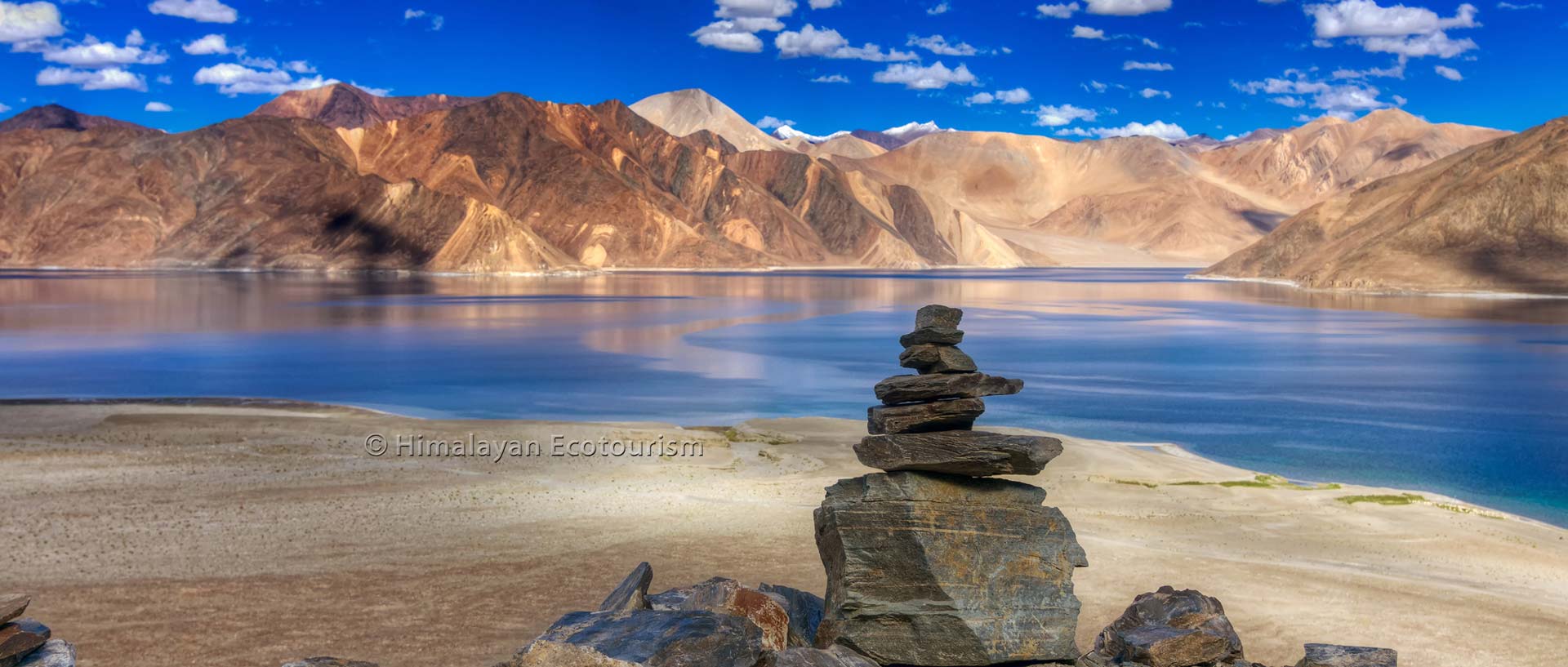


 VIDEO
VIDEO 